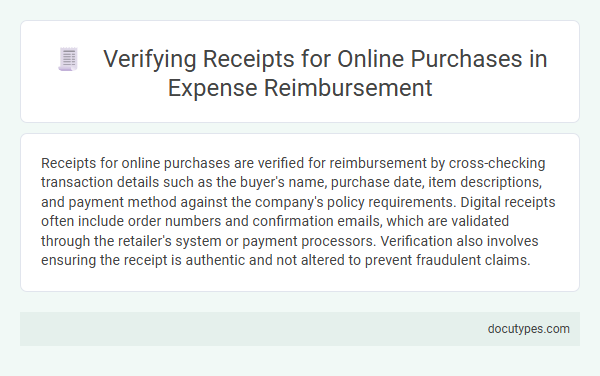Receipts for online purchases are verified for reimbursement by cross-checking transaction details such as the buyer's name, purchase date, item descriptions, and payment method against the company's policy requirements. Digital receipts often include order numbers and confirmation emails, which are validated through the retailer's system or payment processors. Verification also involves ensuring the receipt is authentic and not altered to prevent fraudulent claims.
Importance of Receipt Verification in Expense Reimbursement
Receipt verification is crucial in expense reimbursement to ensure the authenticity and accuracy of online purchase claims. It helps prevent fraudulent submissions and maintains the integrity of financial records. Your reimbursement process relies on securely validated receipts to confirm legitimate expenses and enable timely payment.
Key Elements of a Valid Online Purchase Receipt
Receipts for online purchases are verified through specific key elements that authenticate the transaction and facilitate reimbursement. Accurate verification ensures compliance with company policies and prevents fraud.
- Merchant Information - The receipt must display the seller's name, address, or contact details to confirm the source of the purchase.
- Transaction Date and Time - A clear timestamp is necessary to validate the purchase within the reimbursement period.
- Itemized List of Purchased Goods or Services - Detailed descriptions and prices help verify the nature and amount of the expense claimed.
Verification of these elements guarantees the legitimacy of online purchase receipts for reimbursement purposes.
Common Issues with Digital Receipts
| Topic | Details |
|---|---|
| Verification Process | Receipts for online purchases are verified by cross-checking order numbers, purchase dates, vendor details, and payment methods against transaction records. Digital signatures and QR codes embedded in e-receipts help ensure authenticity. |
| Common Issues with Digital Receipts | Many digital receipts lack detailed itemization or have incomplete purchase information. Some receipts are automatically generated emails that do not include transaction IDs. Formatting errors and missing vendor contact information can cause delays in verification. |
| Impact on Reimbursement | Receipts that fail verification criteria often result in reimbursement delays or denials. You must ensure that your online purchase receipts contain clear vendor names, date, total amount, and order confirmation for smooth processing. |
| Best Practices | Save receipts in PDF format and avoid screenshots or images that may compromise text clarity. Request electronic receipts directly from official vendor platforms to ensure validity. Keep records organized to facilitate quick verification. |
Steps to Verify Authenticity of Online Receipts
Verifying receipts for online purchases is essential to ensure reimbursement requests are legitimate and accurate. The process involves detailed checks to confirm the authenticity of the receipt and transaction.
- Check the seller's information - Verify the name, address, and contact details on the receipt match the legitimate online retailer's official data.
- Confirm transaction details - Ensure the purchase date, items bought, prices, and payment method align with the customer's order records.
- Validate payment confirmation - Cross-reference transaction IDs or payment confirmation numbers with the payment processor or bank statement records.
Tools and Technologies for Receipt Verification
Receipts for online purchases are verified using advanced tools and technologies designed to authenticate transaction details accurately. These systems analyze data such as purchase date, merchant information, and payment confirmation to ensure validity.
Optical Character Recognition (OCR) technology extracts key information from digital receipts automatically. Machine learning algorithms cross-check receipt data against merchant databases and transaction histories. This verification process helps you receive timely and accurate reimbursement by minimizing errors and fraudulent claims.
Detecting Fraudulent or Altered Receipts
How are receipts for online purchases verified to detect fraudulent or altered documents for reimbursement? Verification involves analyzing digital data such as timestamps, transaction IDs, and payment confirmations to ensure authenticity. Advanced software cross-references receipt details with retailer databases to identify inconsistencies or signs of manipulation.
Best Practices for Submitting Online Purchase Receipts
Receipts for online purchases are verified for reimbursement by confirming transaction details such as the date, vendor, and total amount paid. Verification often involves matching the receipt information with bank or credit card statements to ensure authenticity.
Best practices for submitting online purchase receipts include submitting clear, legible copies that show all relevant purchase information. Providing digital receipts directly from the online vendor's platform, along with order confirmation emails, enhances the accuracy and speeds up the reimbursement process.
Compliance Requirements for Receipt Validation
Receipts for online purchases are verified through a combination of data accuracy checks and compliance with company reimbursement policies. Essential elements such as purchase date, vendor information, itemized list, and payment method are scrutinized to ensure authenticity.
Compliance requirements mandate that receipts must clearly reflect the transaction details and match the reimbursable expense categories outlined by the organization. Failure to meet these criteria often results in rejection or further investigation before reimbursement approval.
Policies on Acceptable Receipt Formats
Policies on acceptable receipt formats for online purchase reimbursement typically require clear, itemized receipts showing the vendor, date, and amount spent. Digital receipts in PDF, email confirmations, or screenshots with all relevant details are commonly accepted. Receipts lacking essential information or in unsupported formats may be rejected to ensure accurate verification and prevent fraud.
How Are Receipts for Online Purchases Verified for Reimbursement? Infographic

